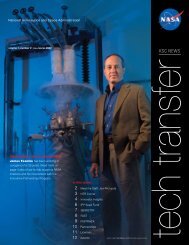2006-2007 - Kennedy Space Center Technology Transfer Office
2006-2007 - Kennedy Space Center Technology Transfer Office
2006-2007 - Kennedy Space Center Technology Transfer Office
- No tags were found...
Create successful ePaper yourself
Turn your PDF publications into a flip-book with our unique Google optimized e-Paper software.
Numerically Modeling the Erosion of Lunar Soil by Rocket Exhaust Plumes<strong>2006</strong> <strong>Center</strong> Director’s Discretionary Fund ProjectIn preparation for the Apollo program, Leonard Roberts of the NASA Langley ResearchSite Preparation <strong>Center</strong> developed a remarkable analytical theory that predicts the blowing of lunar soiland Excavation and dust beneath a rocket exhaust plume. Roberts assumed that the erosion rate wasdetermined by the excess shear stress in the gas (the amount of shear stress greater thanwhat causes grains to roll). The acceleration of particles to their final velocity in the gas consumes aportion of the shear stress. The erosion rate continues to increase until the excess shear stress is exactlyconsumed, thus determining the erosion rate. Roberts calculated the largest and smallest particlesthat could be eroded based on forces at the particle scale, but the erosion rate equation assumed thatonly one particle size existed in the soil. He assumed that particle ejection angles were determinedentirely by the shape of the terrain, which acts like a ballistic ramp, with the particle aerodynamicsbeing negligible. The predicted erosion rate and the upper limit of particle size appeared to bewithin an order of magnitude of small-scale terrestrial experiments but could not be tested morequantitatively at the time. The lower limit of particle size and the predictions of ejection angle werenot tested.We observed in the Apollo landing videos that the ejection angles of particles streaming out fromindividual craters were time-varying and correlated to the Lunar Module thrust, thus implying thatparticle aerodynamics dominate. We modified Roberts’ theory in two ways. First, we used ad hocthe ejection angles measured in the Apollo landing videos, in lieu of developing a more sophisticatedmethod. Second, we integrated Roberts’ equations over the lunar-particle size distribution andobtained a compact expression that could be implemented in a numerical code. We also added amaterial damage model that predicts the number and size of divots which the impinging particleswill cause in hardware surrounding the landing rocket. Then, we performed a long-range ballisticsanalysis for the ejected particulates.The Apollo 12 Lunar Module landed approximately 160 m fromthe deactivated Surveyor III spacecraft. Blowing sand grainspitted Surveyor’s surface with microscopic craters, and theblowing dust particles eroded a thin layer of material from itssurface.Output of modified Roberts’ model showing mass fluxin a 3-D map. Particles ejected from surface craters athigher angles create inhomogeneities.40 <strong>Space</strong>port Structures and Materials













